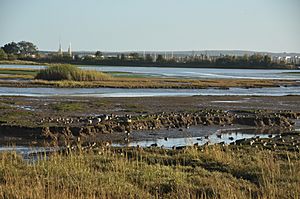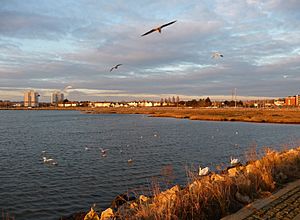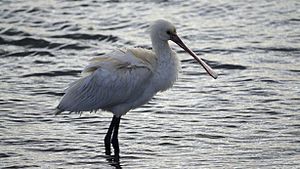Holes Bay facts for kids

Holes Bay is a special part of Poole Harbour in Dorset, England. It's like a big, calm pool of water where the land is covered and uncovered by the sea's tides. This area is mostly within the town of Poole and is a very important home for many different kinds of wetland birds.
Contents
Where is Holes Bay?
Holes Bay is located on the south coast of England. Most of it is in the Borough of Poole, but a small part of its northwestern shore is in a place called Upton. The bay collects water from the heathlands around Creekmoor. It's surrounded by different areas: Sterte and Stanley Green to the east, Creekmoor to the north, Upton to the northwest, Hamworthy to the west and southwest, and the older part of Poole town to the southeast.
What is Holes Bay Like?
Holes Bay is a tidal lake, which means its water level changes with the ocean's tides. It's known as a quiet area within the harbour. The bay connects to Poole Harbour through a narrow entrance between Lower Hamworthy and Poole Old Town. This entrance passes by the RNLI lifeboat station and part of Poole Quay.
Two bridges cross this narrow entrance: Poole Bridge and the newer Twin Sails Bridge, which opened in 2012. Large boats that need deep water can only enter Holes Bay when these bridges are lifted. This happens at certain times each day, and sometimes if a boat asks. The Twin Sails Bridge was built to help stop traffic jams by making sure at least one bridge is open for cars at all times.
The northern part of the bay has a railway line crossing it from west to east. This is the main line from London to Weymouth. Poole railway station is very close to the southeastern corner of the bay. Roads also run along the bay: the A350 is on the eastern side, and the A35 goes along its northern shore.
In the northwest, you'll find Upton Country Park and Upton House, which is a public park owned by the Borough of Poole. There's also a marina (a place for boats to dock) on the western side of the bay, south of the railway line.
There's a small, wooded island called Pergins Island in the north of the bay. It's a private island and not open to the public.
Holes Bay is also where the Royal National Lifeboat Institution (RNLI) has its training school, right next to their main office in Poole. People use the bay for fishing, kayaking, and sailing small boats. A big marina called Cobbs Quay is located on the west side of the bay.
Weather and Tides
The water level in Holes Bay doesn't change much with the tides. During "neap tides" (when the tides are smallest), the water level changes by about 0.6 metres (2 feet). During "spring tides" (when the tides are biggest), it changes by about 1.8 metres (6 feet). The bay also has a "double high water," meaning the tide comes in twice before going out.
The average temperature in January is about 8°C (46°F), and in August, it's about 27°C (81°F). The coldest temperatures are around 3°C (37°F) in winter, and the warmest are about 16°C (61°F) in summer. In winter, the mudflats can get cold enough to freeze. The most common winds come from the west or southwest, but sometimes sea breezes blow in from the south and southeast.
Amazing Wildlife
Holes Bay is a fantastic place for nature, especially for birds and sea creatures.
Birds of Holes Bay
Holes Bay is home to many different wetland birds. You might see birds like the avocet, black-tailed godwit, curlew, kingfisher, little egret, oystercatcher, red-breasted merganser, redshank, spoonbill, teal, and widgeon. It's a very important resting and feeding spot for them.
Fish and Other Sea Creatures
People also enjoy fishing in Holes Bay. Some of the fish you can find here include bass, mullet, flounder, corkwing wrasse, and gobies. The bay is also full of small sea animals without backbones, like king ragworms, clams, and cockles. These creatures live in the mud and are an important food source for the birds and fish.
Plants of Holes Bay
In the early 1900s, a type of grass called cordgrass grew very quickly across the mudflats of Holes Bay. It covered more than half of the area that the tides reached. However, between 1924 and 1980, much of this grass disappeared because of erosion (when the waves wash it away) and the plants dying off.
The area around Holes Bay also has many different plants. You can find woodland wild flowers, special plants that grow in salty marsh areas, and grassland species, including beautiful orchids.
Holes Bay Nature Park
In 2015, the Poole Borough Council, the Dorset Wildlife Trust, and other groups worked together to create the Holes Bay Nature Park. The main goal of this park is to help local people connect with nature and to make sure the habitat is well looked after. This way, the many different types of wildlife that live in Holes Bay can continue to thrive.



